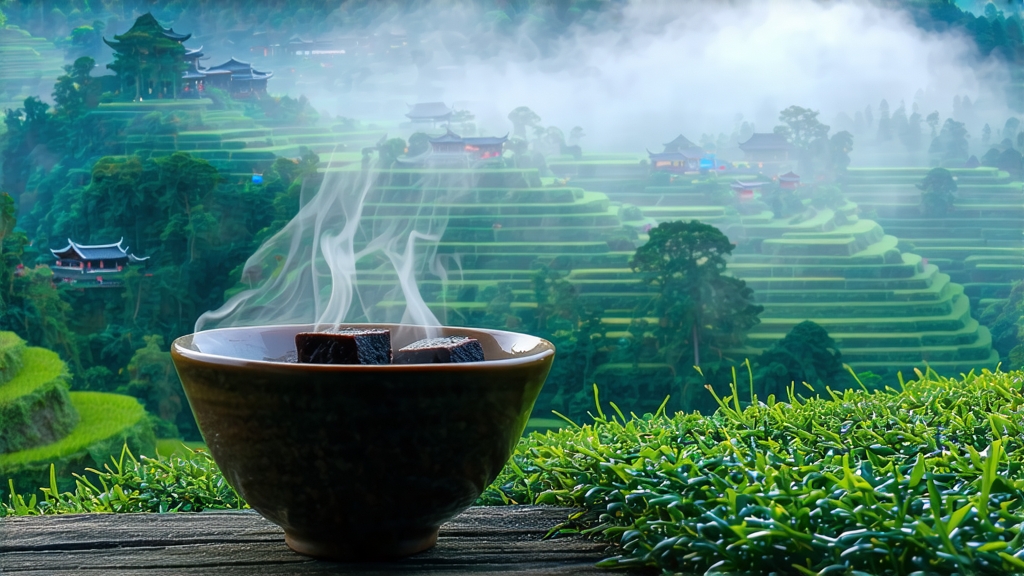
Tucked away in the humid, karst-pocked southwest of China, the small district of Liu Bao in Wuzhou, Guangxi, gave its name to a tea that once fueled the thirst of frontier traders, cooled the blood of dock workers, and still hides in the shadow of its more famous cousin, Pu-erh. Liu Bao cha—literally “Six Forts tea”—is a dark, post-fermented black tea whose history, flavor, and very chemistry were shaped by rivers, markets, and the steady tread of pack animals along the Tea Horse Road. To taste it today is to sip the memory of southern China’s merchant past, a past that begins in the Ming dynasty, lingers in the steam of a clay kettle, and finishes with the surprising sweetness of longan fruit.
Historical footprints
The first written record appears in 1585, when the governor of Guangxi noted that “Wuzhou dark bricks pacify the miasma and quench the thirst of boatmen.” By the Qing era, Liu Bao leaves were compressed into 37-kilogram baskets, loaded onto bamboo rafts, and floated down the Liu River to the Pearl River delta, where dockworkers drank it to ward off dampness and malaria. From Guangzhou the tea sailed to Hong Kong, then on to Malaya and Indonesia, following the Nanyang diaspora. In Kuala Lumpur’s old Chinatown you can still find kopitiams that serve the tea from brass kettles, its surface shimmering with the same reddish halo that once greeted coolies after a 12-hour shift. The colonial British, ever pragmatic, listed Liu Bao as “coolie tea” in 1898 port ledgers, valuing it less for romance than for the way it settled stomachs soured by rice wine and opium.
Micro-terroirs within one name
Although “Liu Bao” is a protected geographical indication, the tea is not monocultural. Within the designation grow three distinct leaf styles, each tied to elevation and cultivar. Guilin large-leaf, originally transplanted from Yunnan, dominates above 600 m, yielding a thick, tarry liquor with camphor notes. Wuzhou native medium-leaf, grown on red sandy loam between 300–500 m, gives the classic betel-nut aroma that old-timers call “gou pi xiang,” recalling the spicy chew once ubiquitous on the docks. Finally, the river-valley small-leaf, plucked below 300 m, ferments faster and lighter, producing a bright crimson cup favored by Hong Kong tea restaurants for cutting through the richness of milk tea. Harvest seasons follow the lunar calendar: spring buds for fragrance, summer rain leaves for body, autumn third-flush for sweetness, and the rare winter “gu hua” pick, when tea bushes absorb the scent of blooming osmanthus.
Crafting darkness: from kill-green to wet pile
Unlike the sun-dried roughness of Yunnao Pu-erh maocha, Liu Bao begins with a short but critical pan-fire. Leaves are tossed for 90–120 seconds in woks heated to 280 °C, hot enough to blister the epidermis yet preserve the enzymes that will drive later microbial fermentation. After rolling and a brief 20-minute sun-wither, the half-dried leaves enter the “wo dui” shed—an airy bamboo structure raised on stilts above the Liu River’s morning mist. Here workers build 500-kilogram piles, spraying them with the same river water that once carried tea to sea. The pile is covered with jute sacks and left to heat; thermometers are plunged into the core like swords, and when the internal temperature hits 58 °C the pile is turned, watered, and restacked. Over 25–35 days the leaves darken, the river’s mineral content feeding a consortium of Aspergillus niger, Blastobotrys adeninivorans, and a lactic acid bacterium unique to Liu Bao, Lactobacillus wuzhouensis. The final moisture drop to 12 % signals readiness; the tea is then steamed, pressed into hand-woven bamboo baskets, and moved to an above-ground warehouse whose bricks are impregnated with spores from decades of earlier teas. There it sleeps for a legal minimum of one year, though connoisseurs seek baskets stamped 1998, 2003, or 2007—years when monsoon patterns left an extra trace of river fog in the leaf.
Basket speak: decoding the mark
Every Liu Bao basket carries a four